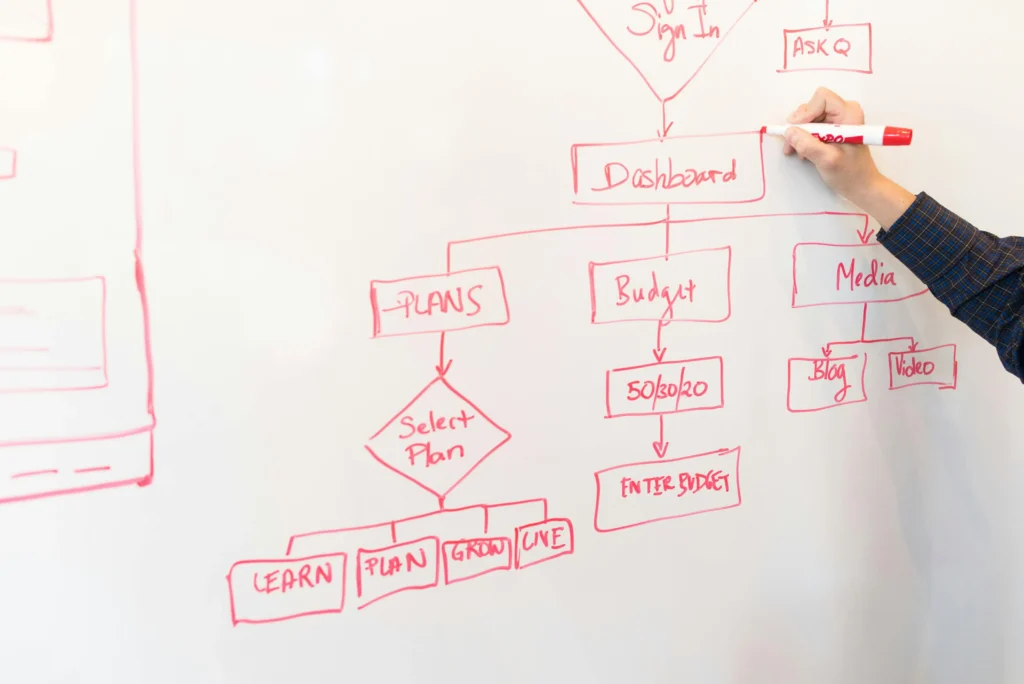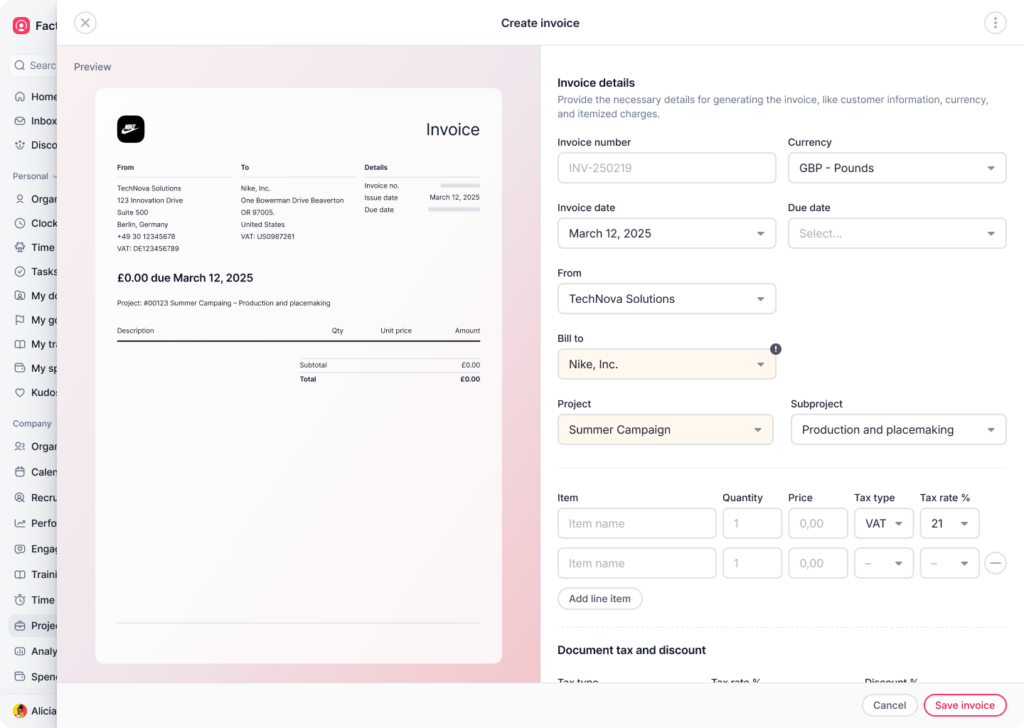In today’s business world, HR professionals are typically involved in a wide range of complex projects, from shaping organisational strategy and developing corporate culture to leading digital transformation and creating fit-for-purpose hybrid working models. To manage these challenging tasks effectively, HR project management is now an essential skill for a high-functioning HR team. In this article, we’ll explore what HR project management is and why it’s so essential, and provide tips on how HR teams can implement it effectively to meet their business goals.
💡Stay on top of all your projects. Download your free project planner template.

What Is HR Project Management?
As you might expect, HR project management involves applying the principles of project management to HR specific operations.
The key aspects of HR project management include:
- Planning: defining the scope, objectives and key deliverables of an HR project.
- Resource allocation: managing the efficient use of human and financial resources for an HR project.
- Team management: finding and bringing together a team with the right skills, experience and mindset, supporting collaboration and managing each person’s contributions.
- Goal setting: establishing clear, achievable goals along with trackable, measurable metrics.
- Risk management: identifying potential issues, such as budget restrictions or resistance to change, and developing strategies to counteract them.
- Stakeholder communication: ensuring employees, team members and senior leaders understand the strategic aims, are updated on progress and engaged with the project.
- Progress tracking: monitoring deadlines and milestones, tracking individual responsibilities and identifying any bottlenecks.
In contrast to more traditional project management, HR project management keeps the focus on the people in the business. It requires a balance between what the company needs to get done and the organisation’s engagement, well-being and culture. One way of looking at this is that general project management asks, ‘What problem needs to be solved and by when?’ while HR project management adds an extra question, ‘How will this impact our people?’.
Examples of HR projects that would require project management include:
- Implementing new HR software.
- Redesigning the performance review process.
- Supporting organisational change, such as digital transformation or a diversity and inclusion programme.
- Rolling out changes to compensation packages, recruitment processes and onboarding programmes.
- Introducing a new learning and development platform.
The Importance of HR Project Management
HR project management enables HR teams to apply structure, accountability, and transparency to initiatives, helping them work more effectively and deliver meaningful results that align with business objectives.
In terms of specific project work, there are several benefits to HR project management:
- Ensures that resources are allocated correctly across the project.
- Streamlines processes and workflows to help the project run more smoothly.
- Better collaboration between team members is more likely to lead to the project delivering meaningful results.
- Identifies risks and helps create plans to mitigate them, reducing potential setbacks to the project.
HR projects that are well run and deliver results can impact the overall business in several ways:
- Structured and visible HR projects can improve employee engagement, foster a sense of purpose, and align the workforce.
- Better project planning reduces waste, ensures compliance as required, and optimises the investment of time and resources, benefiting the bottom line.
- Well-organised HR projects can model good communication practices, influencing how the rest of the business works together.
How to Plan and Execute an HR Project
While all projects are unique to the needs of an individual business, most will follow a similar structure. Here is a seven-step guide to planning and executing an HR project.
Step 1: Define the Goals and Scope
Clarify the problem you are solving or the opportunity you are addressing. Be clear about the project’s parameters and agree on success metrics using the SMART approach.
Step 2: Identify Key Stakeholders and Project Roles
Create a framework to determine who will be involved in the work, who will be affected by the project, and who simply needs to understand that the work is happening. Using a RACI matrix, which allocates people to responsible, accountable, consulted, and informed roles, can be a good place to start. Assigning clear roles (don’t forget you need a project manager!) and responsibilities at the start helps establish project guidelines and secure buy-in.
Step 3: Create Your Plan
Gather all the information you need on current processes, feedback, pain points and benchmarks and research best practices and software options. Then create a project plan with key milestones and deliverables, timelines and dependencies, and required budget and resources. Include a section on risk management to capture any particular issues you anticipate and how you might deal with them. Project management tools or software programmes can be helpful here by providing visual dashboards.
Step 4: Communicate the Plan
Once you have your plan in place, spend time running through it with key stakeholders and establish a clear communication plan outlining who needs to know what and when. Ensure the entire project team understands the project’s key messages and the importance of maintaining open, consistent, and transparent communication.
Step 5: Implement
Kick off the project! It can be a good idea to pilot something with one department at first to test for any issues. Ensuring that staff are trained and have the appropriate resources and technical or psychological support as the project rolls out is also essential.
Step 6: Monitor and Adjust
Tracking how the implementation phase is progressing against your planned goals and milestones is essential for identifying what is working and what is not. Be ready to refine or completely pivot on specific parts of the project based on the feedback you get.
Step 7: Evaluate and Close
Once the project is complete, measure the results against the success metrics you established in Step 1. Make sure you gather feedback, document any lessons learnt, and share the outcomes with stakeholders. Don’t forget to celebrate the success, but also communicate that you will continue the work. The HR team should model an ethos of continuous improvement.
Common HR Project Examples
To fully understand how project planning can benefit HR projects, let’s look at three different common HR projects:
- Revising the Performance Review Process
The performance review process can be time-consuming, inefficient and demoralising if not run well, so it’s no surprise that many HR departments find themselves revising how it works.
Goal: create a more efficient performance review process with timely feedback at its heart
Challenges: low manager engagement, outdated methods of providing feedback
Outcome: increased participation rates, improved employee engagement, better performance
- Implement an HRIS (Human Resources Information System)
An HRIS is a digital system to manage HR processes and documentation. It streamlines workflows and saves time, but implementing one involves work in both deciding which platform to invest in and in onboarding and training staff to use it.
Goal: centralise employee records, automate administrative tasks, streamline workflows.
Challenges: managing resistance to a new system, integrating legacy systems and ensuring data accuracy
Outcomes: seamless running of payroll, increased rates of employee self-service, reduced time on administration
- Launching a Cultural Change Programme
Organisations often realise they need to shift their corporate culture, either to be more inclusive, to focus more on feedback and continuous improvement, or to improve collaboration and creativity.
Goal: build a workplace that reflects the values agreed by strategic stakeholders
Challenges: getting organisation-wide commitment, measuring objectives on behavioural metrics
Outcomes: improve retention rates, better employee engagement
Tools and Software for HR Management
Software and digital tools play a crucial role in today’s approach to HR project management. Where previously we may have used spreadsheets filled in manually and communicated via long email threads, now digital platforms exist which automate much of the organisation required for project management, simplify collaboration between teams, enable tracking of progress and provide insights that drive better decision-making.
Factorial: All-in-One BMS with HR Project Management Software
One option for HR project management software is Factorial, which offers an intuitive, centralised approach to planning, executing, and monitoring HR projects. Its HR project management platform has the ability to create sales invoices directly from your projects without manually entering your client’s information. Additionally, it offers kanban board solutions, collaborative tools and full visibility into the progress of your projects.

Factorial supports HR project management in the following ways:
- The centralised dashboard supports tracking, timelines, and clear visibility into dependencies.
- Collaboration tools allow team members to assign tasks, share documents and communicate updates all in one place.
- Integration with core HR tools, such as leave management and payroll, ensures alignment between schedules, resources, and well-being, which is essential for effective project management.
- Performance insights from reports allow team leaders to track the HR project’s strategic objectives.
Using Factorial’s business management software for HR projects allows businesses to stay organised, make data-driven decisions and – crucially – maintain an overview of the people element of the project.
👉 Book a demo with one of our experts at Factorial today to learn how you can simplify HR project management for your business.
HR Best Practices for HR Project Management
Good project management for HR projects not only ensures that the project is efficiently organised and set up for the successful delivery of its objectives, but it also fosters collaboration, drives engagement and builds in flexibility for when priorities evolve.
Here are three best practices:
Ensure the HR Project Aligns with Business Strategy
When an HR project has clearly defined objectives that align with an organisation’s overall objectives, it helps everyone understand why it is important, thereby improving engagement and increasing the likelihood of success. Get stakeholder feedback early and encourage buy-in from the start. Mark the launch of the project with clear communication of its strategic aims, and keep everyone updated on how it’s going and the impact it is having on business objectives.
Communicate Often, Communicate Well and Communicate Clearly
By definition, HR projects have people at their heart. Good communication creates a human connection, which is key to ensuring that an HR project has the information it needs and involves the right people. It is also essential to help the wider workforce understand why the project is important and how it will benefit the whole business.
Use Software to Provide Structure and Save Time
Modern digital platforms are the foundation of a successful HR project because they automate workflows, improve accuracy, and provide real-time visibility into project progress. Software systems such as Factorial make it easy to organise and structure HR projects while providing accurate data, which improves decision-making. By centralising the processes involved in the HR project, these platforms free up time to focus on meeting the project’s strategic aims.
Final Thoughts about HR Project Management
Effective project management for HR initiatives can elevate an HR team from an operational function to a strategic partner. From launching new cultural initiatives to improving the employee experience, cost-reducing exercises to major change management projects, HR teams that use a structured project management approach achieve better results and more quickly.
Interested in streamlining and centralising your HR project management? Check out Factorial’s robust all-in-one platform to monitor your projects whilst streamlining your HR workflows.
Frequently Asked Questions
1. Can HR do project management?
Yes! HR teams often manage multiple projects, including those related to business change or HR-specific initiatives such as recruitment, onboarding, performance, and culture. Using a professional project management approach ensures these initiatives are well organised and structured, measurable and aligned with business goals.
2. What is HR project management?
HR project management applies project management principles to HR initiatives, helping HR teams successfully plan, execute, and evaluate their projects.
3. What are examples of HR projects?
Typical examples where HR uses project management skills include implementing an HRIS or another new software system, such as a payroll system, revising the performance review process, or driving a change in corporate culture.
4. What tools are used in HR project management?
Software like Factorial’s business management systems supports HR teams to manage projects by assigning tasks, tracking time, and analysing performance data. Other project management tools that are helpful include Gantt charts, Kanban boards and RACI templates.


